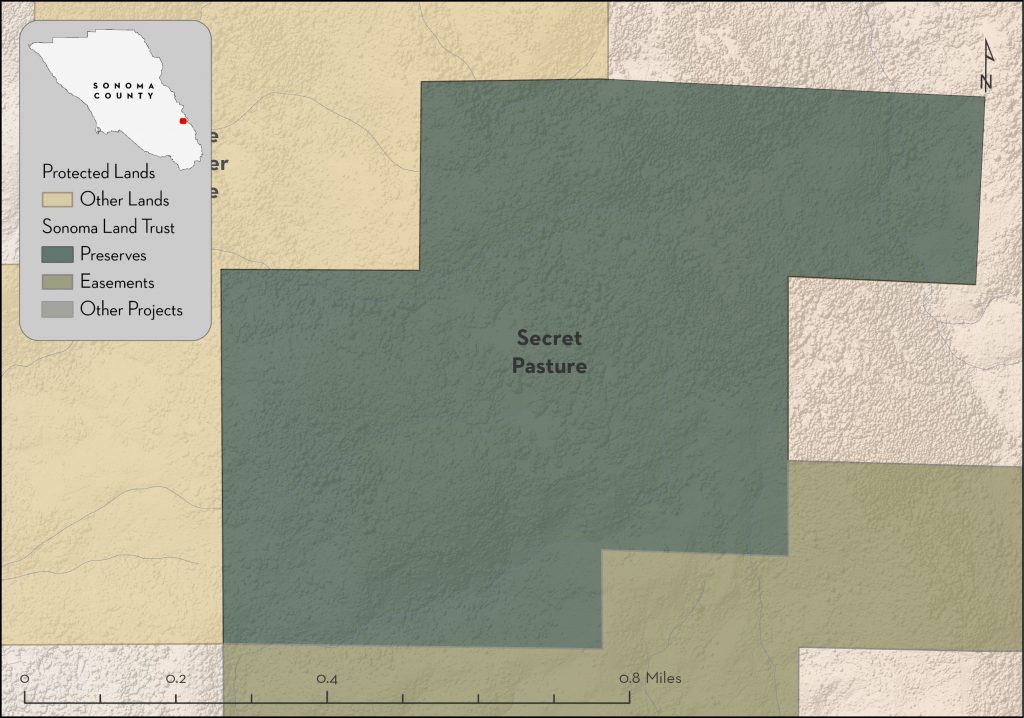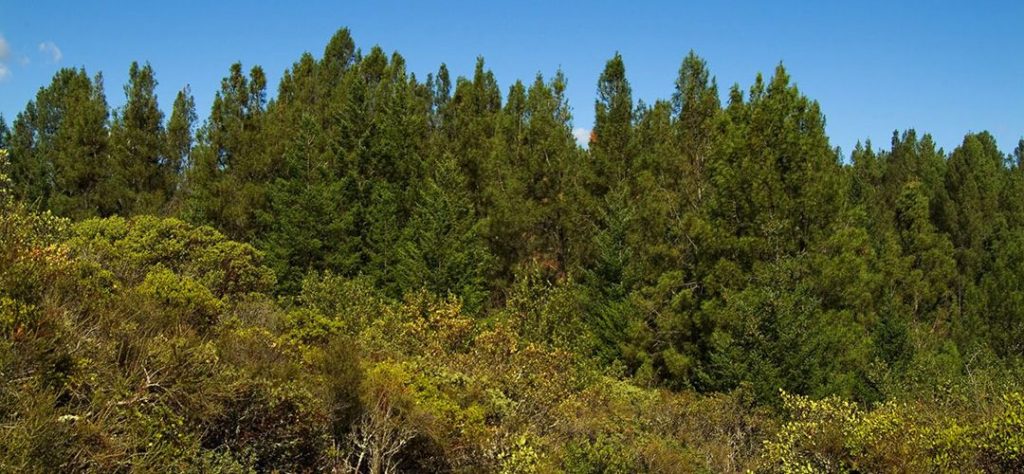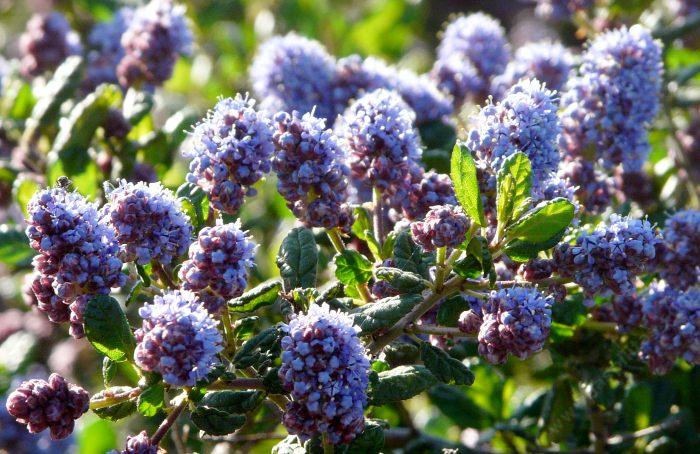SECRET PASTURE
Property Type
Ecological Preserve
Acreage
339
Protected in
1979 & 2012
Region
Sonoma Valley & Mountain

“Perched on a mountainside high above Sonoma Valley, Secret Pasture holds a singular place in local history. Its greatest assets have always been its inaccessibility combined with a vantage point over the region. Even today, it is not easy to get to: Its very remoteness sparks the imagination and contributes to its prominence in local folklore.”
— Arthur Dawson,A Cultural and Ecological History of Secret Pasture Preserve
Rooted in Local Folklore
Secret Pasture presents a rough landscape of grey pine, chaparral and oak woodlands typical of the Mayacamas Mountains. Located near where the headwaters of Stuart Creek begin, red-tailed hawks soar above the landscape and deer, cougar and, we have reason to believe, porcupines live and thrive here. Part of the Sonoma Valley Wildlife Corridor, this preserve is connected to thousands of acres of relatively undeveloped land across Sonoma Valley and is further connected to larger areas of habitat in Napa and Marin Counties. It is a dynamic landscape, important to protect and manage for biodiversity, now and in the future.
It seems appropriate that this 340-acre preserve, situated atop the Mayacamas above Glen Ellen, was Sonoma Land Trust’s first protected property. It was donated to the organization by Otto and Anne Teller, who also donated a conservation easement over their adjacent Oak Hill Farm. Overlooking the Sonoma Valley, this preserve is unassuming at first glance, but, as local historian Arthur Dawson notes, its remote and inconspicuous location is the very reason it holds such prominence in Sonoma’s history.
Local legends contend that Secret Pasture was the site of an historic battle between Wappo warriors and General Mariano Vallejo’s soldiers, as well as a hiding spot for infamous cattle rustlers, like Three-Fingered Jack and Joaquin Murieta (though these reports are unverified). Still, gazing across the valley from Secret Pasture’s high vantage point and remote location, it is easy to imagine that it was, indeed, a most fitting location for these incidents to occur.
Long before outlaws and soldiers presumably occupied the land, Native Americans, likely ancestors of the Wappo tribe, arrived in the valley as its first human visitors more than 10,000 years ago. Though the early people mostly inhabited lower, flatter areas, Secret Pasture probably served as a seasonal hunting and camping spot.
When Mexico started colonizing the area during the 19th Century, Wappo were divided between choosing to join the missions or resist the incursion of newcomers, resulting in a battle that some believe took place at Secret Pasture. Years later, the land may have become the site of another local legend, Mexican native Joaquin Murrieta (who some considered to be a freedom fighter), using Secret Pasture as a site from which he and his men defended their homeland against foreign invaders.
As Dawson muses, the Tellers were, in their own way, “following in the footsteps of the Wappo and Joaquin Murrieta, using Secret Pasture as a base from which to defend and protect a place they cared for deeply.”
Download A Cultural and Ecological History of Secret Pasture Preserve.
Fire History of Secret Pasture
Fire has been and will continue to be a major force in shaping the vegetation patterns at Secret Pasture. Recent history and the kinds of plants found there tell us that the landscape of the Mayacamas Mountains is fire adapted. The native grasses, shrubs and trees (the habitat) evolved over the past few thousand years with fire as part of their normal lifecycle. You can see this evolution in how the plants respond after a fire has swept through — pine trees that only open their cones after they have been heated, manzanita and scrub oak sprouting from the still live stumps of burned vegetation, and flowers that sprout only after fire has moved through the area.
Oral history and documents from early explorers tell us that Native Americans regularly burned the land of the Sonoma Valley, helping to recycle nutrients into the soil, clear out brush and keep pests in check. This provided important food, fiber and tools for their daily use.
History occurred again in October 2017 as several wildfires swept through Sonoma Valley. Secret Pasture’s 340 acres burned thoroughly, eventually sweeping down the hillside into the valley and our adjacent Glen Oaks Ranch. The chaparral habitat up top burned the hottest and lost most of its vegetation. As of Spring 2018, the chaparral remained blackened, but oaks, madrones and manzanitas were vigorously re-sprouting, Fremont’s star lily had exploded across the hillsides and wildlife had returned to their normal routines.
Secret Pasture is one of Sonoma Land Trust’s ecological preserves and is not open to the public.
Ridgeline “Ribbon” of Habitat

Secret Pasture Preserve has no roads and is landlocked. It has no human structures, including fences, and the creeks on the property are not dammed or diverted. It is 340 acres high up in the Mayacamas Mountains of native habitat with little disturbance. Nestled between Audubon Canyon Ranch’s Bouverie Preserve and the forever-protected Oak Hill Farm (whose owners donated Secret Pasture to Sonoma Land Trust many years ago), the preserve is the center of more than 1,000 acres of continuous, high-quality habitat. As such, it is not only a safe haven for resident wild animals, but also an important link in maintaining a functional wildlife corridor across Sonoma County from the Mayacamas to Sonoma Mountain. Secret Pasture remains a truly wild place above the bustling lowlands.
High-quality Habitat

One of the Land Trust’s more remote and pristine properties in the Sonoma Valley region, Secret Pasture Preserve boasts a remarkable biodiversity of plants and animals. When it comes to native California woody shrubs, there are at least four different species of both manzanita and ceanothus, among many others, such as silk tassel, redberry, chinquapin and more. This diverse habitat is subsequently home to some interesting wildlife as well — such as porcupine, whose rare presence was documented on the property in 2015.




